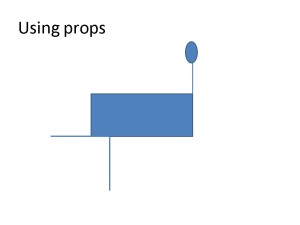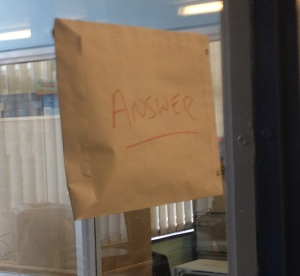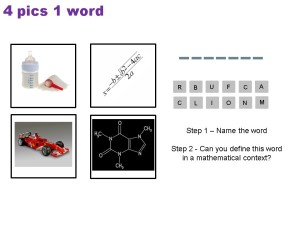 We were delighted that our second presentation on Magic Monday 2 was a joint effort between Ste Hall from our Science department and Andi Clarke from our Maths department, who shared with us a range of ideas to help get our lessons off to a positive start.
We were delighted that our second presentation on Magic Monday 2 was a joint effort between Ste Hall from our Science department and Andi Clarke from our Maths department, who shared with us a range of ideas to help get our lessons off to a positive start.
Hooks and fascinators
Ste kicked things off by showing us a prop he uses to hook students in and get them thinking about forces…
…which generates further prompts and questions, as well as engaging them straight away
“Can we open the box to see what’s inside?”
Students are then given a visual representation of the hook and are asked to explain what is happening in terms of forces using arrows to represent them.
The balloon is then burst to create cognitive conflict. Most students (and our staff for that matter!) think the balloon is holding up the box, so when the box stays suspended, they have to think again. What’s really happening is that the weight hidden inside the box provides sufficient downwards force at the edge of the table to keep the box on the table, as shown below.
The point being that as well as being intrigued from the moment they enter the room, students are also thinking about and talking about their learning straight away.
Annoying catchy songs
Ste then shared how he uses “catchy” songs to reinforce memorisation of key points, for example this one when teaching about the phases of the moon.
There’s a whole world of weird and wonderful examples available on the internet and YouTube – all you need to do is google them. To put this to the test I experimented myself……..
Volcanoes: 3.5 million results
Trigonometry: almost 1 million results
The periodic table of elements and their uses: 700,000 results
…in other words, there is plenty to choose from on any subject you care to mention.
Teach like a pirate
Inspired by Dave Burgess’ book, Ste went on to encourage us to be daring, adventurous and to set forth in unchartered territories with no guarantee of success – in other words to “teach like a pirate”. Teaching like a pirate is all about engaging students and evoking their (and our) passions.
P assion
I mmersion
R apport
A sk and Analyse
T ransformation
E nthusiasm
Teaching like a pirate is about finding something within that not-so exciting lesson to be excited about, rather than every lesson being an amazing, awe-inspiring techno-fest. It could be as simple as adding music, video clips, a different location etc.
Magic and mystery
We were then treated to a mathematical magic trick to introduce the concept of the ‘order of operations’ when performing calculations (or BIDMAS). An envelope with the word “answer” on it was stuck to a window at the front of the room.
Volunteers were asked to type in any random number to the calculator on a mobile phone that was passed around. Each new person was asked to multiply any additional number of their choice before the last person finally pressed the “equals” button.
The contents of the envelope were then revealed as a piece of paper with the number
243627
written on it, which matched the number on the screen of the calculator on the mobile phone .
The secret? Having already entered the sum
243627 + 0 x
the number on the screen appears as 0 to any person inputting numbers after this.
Any series of numbers multiplied after this will always return the value 243627 when the equals button is pressed, as according to BIDMAS the multiplication part comes first, so anything multiplied by zero is zero, which when added to 243627 = 243627…………..ta da!
ToonDoo
We then heard about ToonDoo – a fast, easy way to create cartoons which Ste came across in Hywel Roberts’ book “Oops – helping children learn accidentally”. ToonDoo contains a number of functions that allow you to create, personalise, and publish cartoons.
There are a number of possible benefits to using cartoons and illustrations in lessons. Some concepts that can be difficult for students to understand textually can be communicated in pictures. Illustrations can also be used to get students attention or increase their interest in a topic, or to summarise or rephrase information and help students build their framework of understanding.
Use the news
Next up Andi spoke about how she uses interesting news items to promote interest and engagement, some examples of which are shown below:
Puzzles
Spurred on by “Idea 1: Snappy Starters” in her copy of “100 Ideas for Outstanding Lessons” Andi also shared how she has been using puzzles to make sure her students are engaged from the outset, for example this one based on the popular app “4 pics 1 word”
Jigsaws
Andi’s advice when using jigsaws was to use a grid rather than jigsaw puzzle type pieces to save time preparing the resource without really compromising the activity.
Code cracker
We then had a go at cracking a code by working out the answers to a series of questions, before putting this information together to work out a final code.
The first person to crack the code had to enter it to a simple Microsoft Word file that was password protected to open the document up and reveal the contents of the safe.
Tarsia
Andi also shared how she uses ‘Formulator Tarsia’ – a free to download programme which can be used to create all kinds of puzzles quickly and easily, for example jigsaws, dominoes, follow-me cards or matching cards.
You can download the free software at http://www.mmlsoft.com/index.php/downloads by scrolling down and selecting the Formulator Tarsia installation package.
Vivo cheques
To finish, Andi told us how she uses a post box in the corner of her room for Vivo cheques, which she rewards students with during all of her starter activities to further motivate and engage them.
Thanks to Ste and Andi for an ‘engaging’ presentation, packed full of ideas!




















